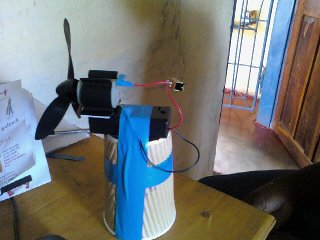R&D: Robots and Development
The Samfya Resource Centre is a telecentre (Internet cafe) run by young women in Samfya, Zambia for other local young women - a component of Camfed's "CAMA" network. As part of our ongoing support for the Samfya Resource Centre, we have sent them robots.
Why robots? As a child I grew up programming the Sinclair ZX81. A small computer about the size of a book, with a touch-(in)sensitive membrane keyboard and 1kB of memory. With computers we spend long hours staring at the screen interacting with a virtual world made of intangible pixels. I remember being constantly frustrated that my computer couldn't do anything in the REAL world. It couldn't turn lights on and off, it couldn't move and back then it couldn't even makes noises. In fact I killed the poor thing when I dropped a soldering iron through the CPU while trying to interface it to my physical world.
It's all different now. With the advent of devices like the Arduino it's now easy and cheap to get the computer to reach out into our world. And we can reach into its world. Not only does an Arduino let us physically interact with the computer it can also be automonous. We can make things that interact with us without needing the computer attached to the other end of its USB umbilical cord.
For those that haven't come across it yet, an Arduino is a simple micro-controller board. OK... what's so amazing about that, there's been micro-controller boards around for decades? Well, a few things. Firstly it has a USB port so you can easily connect it to your computer. It has its own simple programming environment using a variant of the C programming language. So it's not dumbed down at all - no visual programming environment or anything like that. And critically there is a large on-line community eager to share and support people who do not come from a technical background. Its design is open source, it's cheap (£20) and you can find even cheaper clones.
This exploding field called "Physical Computing" is making computing more fun, more compelling and also sometimes more useful.
Ok robots might be fun, but why send them to Zambia?
The computer used to be like a calculator on steroids. It could "compute" things. If you knew a bit about SIN or COS you could make it draw a circle. Or calculate a volume. Now, although computers are enormously more powerful than the Sinclair ZX81, most of us use them like some mash-up of a TV and a phone. They give us access to information and lets us communicate. These are important and useful functions. But I worry most of us are in danger of treating our computers like new cars - like devices with "no user serviceable parts inside". Instead of seeing them as tools that we can fix, modify, improve, re-invent and tailor to our needs.
It's more than that. Computers aren't just useful for the stuff they do. I believe that programming computers, tinkering with them, making electronic circuits and building robots builds highly transferable skills. Critical thinking, logical and abstract reasoning and problem solving. In addition, programming an Arduino makes you a dab hand at searching the Internet.
I got into robots at BuildBrighton / BrightonRobot - the Brighton hacker-spaces based out of The Skiff - and in particular through Steve Carpenter's amazing kits.
As an introduction to robotics, we've used the "DrawBot" packaged up by Steve with excellent instructions. How complicated and expensive do you think an autonomous drawing robot would be? How about 6 components that require no soldering costing about £3?
Steve has also designed a great robot kit based around the Arduino - the BoxBot. The kit is designed using the Interlocking T-Bolt Construction method, a cost-effective technique for low volume manufacture. With servos and everything you need minus the Arduino, the kit's about £60. It's a very flexible kit, you can bolt sensors or motors all over it - but this is not Lego. You need to drill holes in it.
Reading the educational posts about robotics I can see that from a teacher's point of view an Arduino and the BoxBot may not be ideal. They don't neatly fit into lesson plans. They don't just leap into life in a way that keeps a lesson of 30+ students moving along. They take a bit more application and research to use. But unlike Lego, Meccano and other modular systems, they blur the distinction between the kit and the rest of the world. Once you're empowered to drill holes and wire up your BoxBot you find you're up for drilling holes and wiring up anything.
Using robots in this context is an experiment for us. We don't know how it will go. But it's an experiment the young women of the Samfya Resource Centre are excited about.
We'll keep you posted on the progress of our latest bit of R&D.
"Hi" and "Mulishani" to Bridget, Everlyn, Fatuma, Mary, Mildred and Penelope at the SRC from the Aptivate gang!



Hey, so did the girls at the SRC actually put that thing together? Do they still have their video camera, are we going to get some footage?
Hi Mark, The SRC managers did indeed put the drawbot together. I was promised some phone-video footage. I'll chase up Fatuma.
I'm a Nigerian,a varsity student. I was impressed when i read about you and your aims for the third world.I personally, as a student of computer Engineering and a thinker-i mean a philosopher and a scientist-has been excogitating on how to make robots which will behave exactly like humans-i mean with their own orientation.This has been my burden for than a year now,thank God I'm now near to realising it.So,in a nut shell i would like you-the organisation -to please come to my aid-interms of basic tools(infrastures) i may need to achieve this goal of mine. Undoubtedly,you know this Africa where technology advancement is infinitesimally low. Thanks